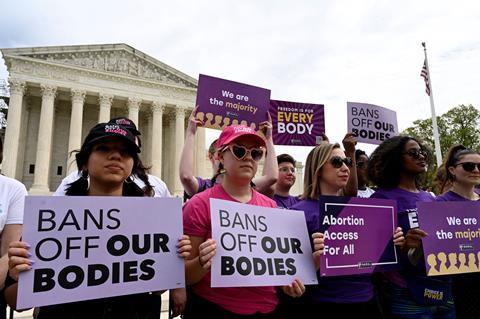Tangle between regulation and politics makes uncomfortable viewing from industry
I’m going to write about mifepristone and the legal troubles around it, and I will probably regret doing so. That’s partly because the situation is changing – this dispute is now before the US supreme court, and for better or worse, they will have the last word. But as of this writing, that last word hasn’t been handed down, and it’s unclear when it will be (although it should be soon).

Another reason to regret taking up the topic is that it’s a tangle of regulatory law and politics, and I have never enjoyed the smell of that combination in the oven. First, the chemistry and biology to take refuge in: as readers will likely know, mifepristone is a progesterone receptor ligand, at least in this use. Blocking the progesterone pathway causes the mucosal lining of the uterus to degenerate, and a follow-up dose of the prostaglandin misoprostol accelerates that lining being shed. The combination is highly effective for ending a pregnancy within the first two months.
And that, of course, is where the trouble lies. Many people oppose abortion for religious and various other reasons. The English writer Samuel Johnson, while visiting Scotland, said he did not inquire about the methods used to produce Scotch whiskey because he did not wish to know more about the art of making poison pleasant. Well, to an abortion opponent, mifepristone makes murder convenient. I don’t share that view, but that’s as succinctly as I think it can be stated. Those on the other side of the issue do not regard a developing embryo that young as an actual human being yet, and say that decisions about the mother’s bodily functions belong with the mother.
There’s enough regulatory uncertainty already, and letting every federal judge take a swing at therapies they dislike is exactly what we don’t need
The two drug combination was approved in the US in 2000, and has been used millions of times since then. That use has steadily increased, as the drug has been made more easily available over the years. The latest move, during the pandemic, was to approve its dispensing by mail-order pharmacies, and that is a key part of the latest challenge. There is an 1873 US law that prohibits sending drugs or devices to induce abortion through the mail, and although much else has been altered in that statute, that language has not. The legal office of the US Postal Service (USPS) weighed in on this last December, saying that the 1873 act was written to prevent illegal activity, but since then abortion has become legal (although this is currently being fought out state by state after the 1973 Roe v Wade supreme court ruling protecting women’s rights to an abortion was overturned in 2022). Moreover, the drug combination itself is, of course, legal, since it was approved by the Food and Drug Administration (FDA). Therefore, says the USPS, this provision does not apply.
The anti-abortion groups who brought the latest suit disagree, as you might imagine. They also say that the FDA approval was mishandled from the start (and in the years since, as restrictions have eased). The 1873 law applies, they say, and the drug combination is in fact illegal since (in their view) the FDA violated its own rules while regulating it. A federal judge in Texas agreed with this reasoning – loudly and wholeheartedly, if you read his decision – and basically overruled the 2000 drug approval. Meanwhile, a federal judge in Washington state almost simultaneously ordered the FDA not to do anything to the availability of the drug while such cases were before the courts.
Thus the legal appeals, which are before the supreme court as I write. There are several issues here: does the 1873 law still apply? Was the FDA’s original approval valid? If so, then are the later eased access requirements themselves valid? And can a federal judge step in and overrule a regulatory agency’s drug approval in the first place? No one has ever tried, and the very thought that this might become common makes almost everyone in the biopharma business feel ill. There’s enough regulatory uncertainty in this line of work already, thanks ever so much, and letting every federal judge take a swing at therapies that they find a reason to dislike is exactly what we don’t need.
My own guess is that the supreme court will do what it often tries to – tiptoe through with as narrow a ruling as possible while dodging the larger issues. But they don’t (or can’t) always do that, and this could be one of the exceptions. We can only wait. What a mess, though. What a terrible mess.

















No comments yet